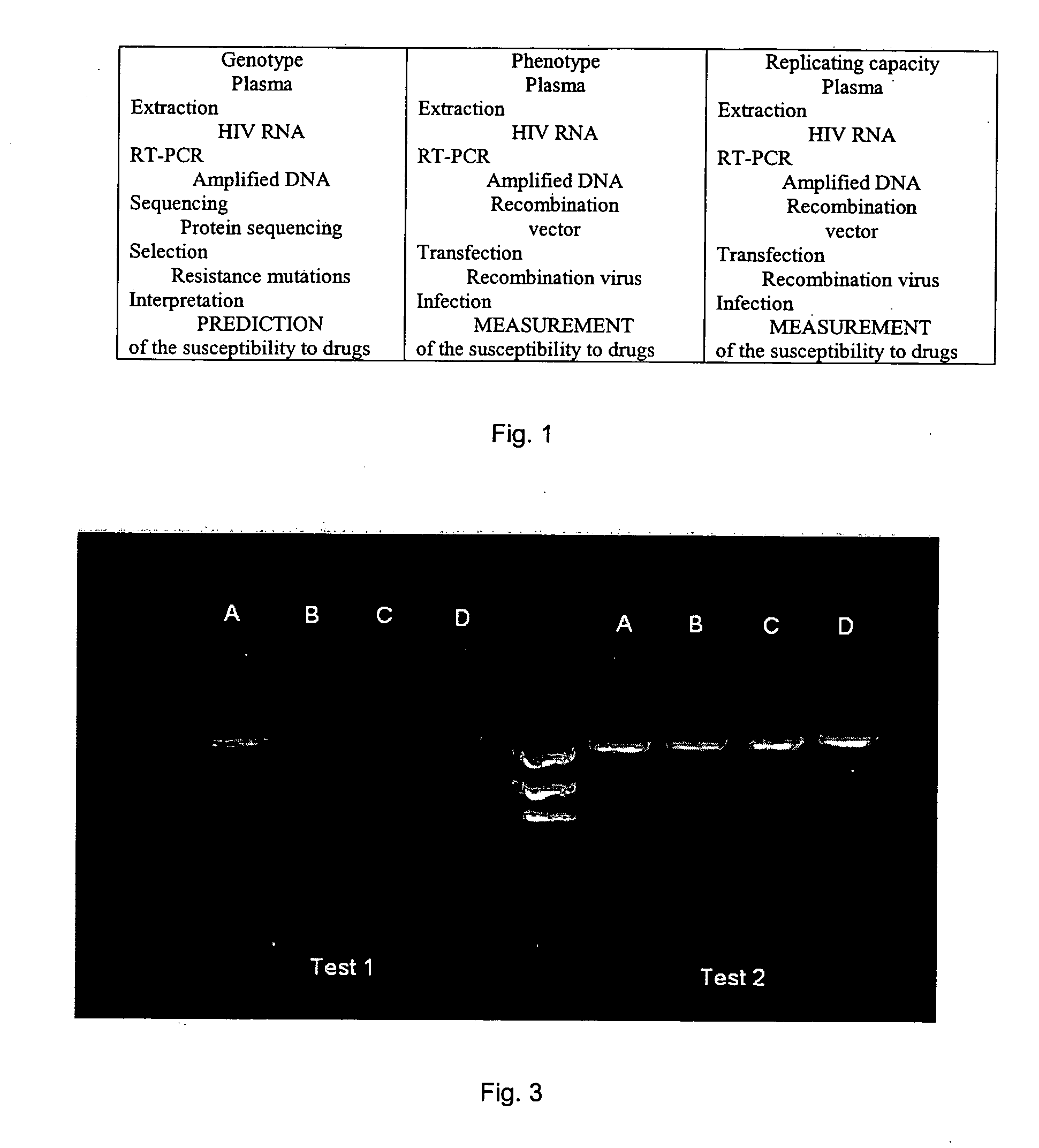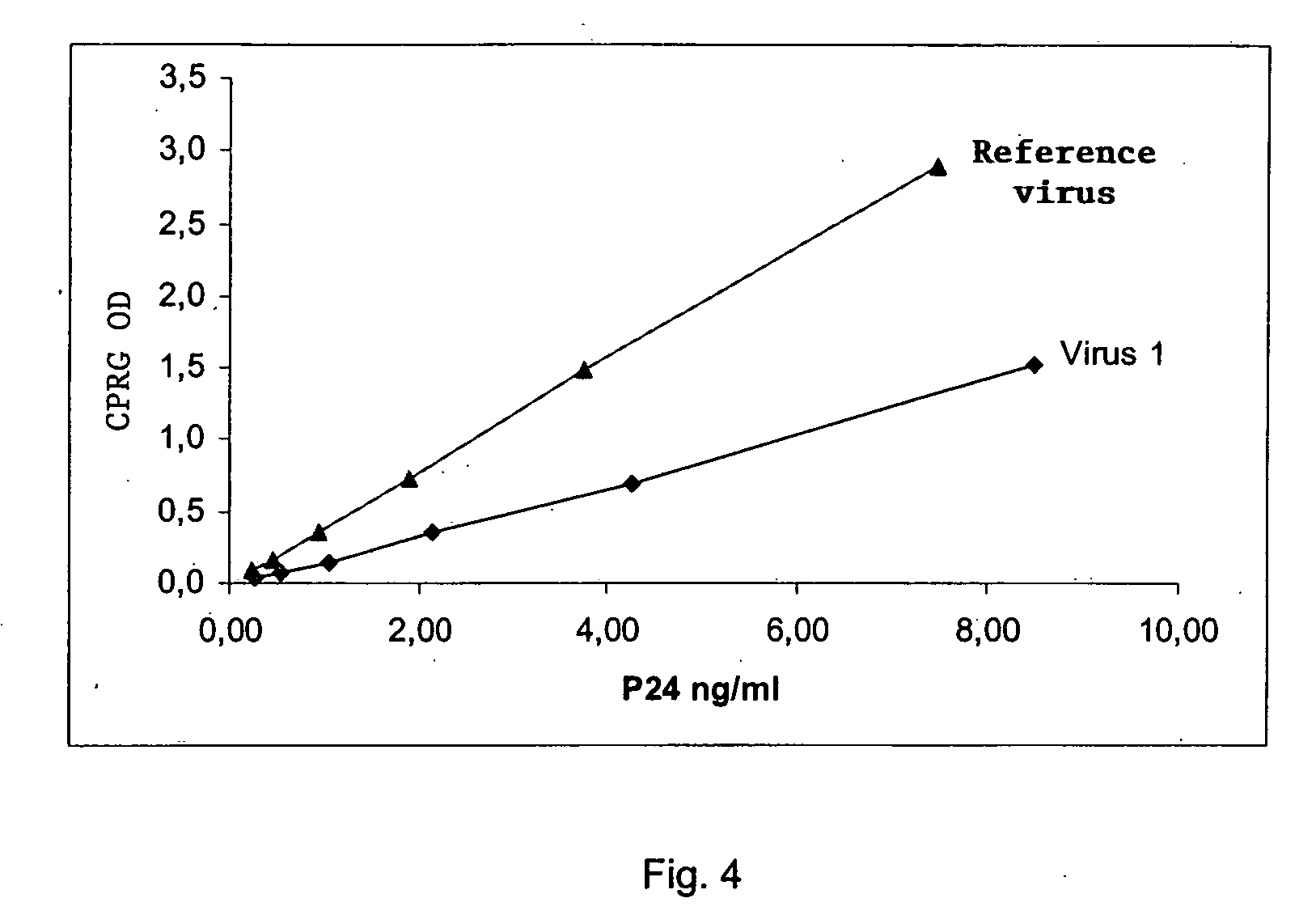Method for study of the genetic and functional variability of HIV and kit for using it
a technology of hiv and genetic variability, applied in the field of virus analysis for human immunodeficiency virus type 1, can solve the problems of low compliance, large decrease in viral replication, and complicated drug combinations, and achieve the effect of improving the efficiency of the immune system
- Summary
- Abstract
- Description
- Claims
- Application Information
AI Technical Summary
Problems solved by technology
Method used
Image
Examples
example 1
Genetic and Functional Analysis of the Protease and the Inverse Transcriptase
[0125] The method in one aspect comprises generation of a specific nucleic acid simultaneously compatible with the genotyping and phenotyping techniques.
[0126] The procedure to generate the first specific amplicon is as follows: [0127] 1) Viral RNA contained in a biological sample is extracted. The biological sample may be derived from a sample from the patient. It may be a blood or serum sample, but may also come from a biological fluid or a biopsy or any other tissue preparation. The biological sample may also come from a viral culture. In a general manner, a biological sample corresponds to all types of samples containing one or several HIV-1 variants. The term “HIV-1 virus” in this Example is used to mean any viral strain belonging to the sub-types B and non-B. [0128] 2) The RNA obtained in (1) is retrotranscribed and amplified with one of the pairs of specific primers in Table 1 below to obtain an am...
example 2
Analysis of the Replicating Capacity of the HIV Virus from Patients having Mutations in the Protease and the Inverse Transcriptase
[0137] In this example, the method comprises the following steps: [0138] 1) The viral RNA that is contained in the biological sample is extracted. [0139] 2) The RNA obtained in (1) is retrotranscribed and amplified with a pair of specific primers making it possible to amplify in a regular manner a specific amplicon comprising at least two genes of interest in the study of the resistance to anti-retroviruses, as described in Example 1. [0140] 3) A new amplicon using the amplicon obtained in step (2) above is prepared by using a new pair of primers described in Table 4 below. This new amplicon is characterized by:
[0141] the presence, at 5′ and at 3′, of conserved zones to allow recombination with the retroviral vector;
[0142] the presence of all the mutations of interest that have already been described;
[0143] the presence of part of the sequence of nucl...
example 3
Compatibility of the Amplicon of Example 1 and 2 with Different Commercial Tests
1) Compatibility with Main Commercial Tests for Genotyping
[0153] Four main commercial tests are described in an article by W. Cavert and H. H. Balfour (Detection of antiretroviral resistance in HIV-1 Clin Lab Med 2003 23:915).
1.1) Trugene kit (Bayer Visible Genetics Inc.) (WO 02 / 070731; Grant et al. Accuracy of the Trugene HIV-1 Genotyping kit J Clin Microbiol 2003 41:1586)
[0154] The Trugene HIV-1 genotyping kit is used to determine the genotype of the virus of sub-types B and non-B. The RNA is extracted using plasma from patients, according to known techniques, the viral RNA is retrotranscribed and amplified using PCR with primers specific for the pol gene making possible amplification of a sequence of nucleic acids of 1300 pb comprising, for the protease, codons 1 to 99 and comprising, for the inverse transcriptase, codons 1 to 247. The product of RT-PCR thus obtained is used in each of the 16 se...
PUM
| Property | Measurement | Unit |
|---|---|---|
| Fraction | aaaaa | aaaaa |
| Fraction | aaaaa | aaaaa |
| Fraction | aaaaa | aaaaa |
Abstract
Description
Claims
Application Information
 Login to View More
Login to View More - R&D
- Intellectual Property
- Life Sciences
- Materials
- Tech Scout
- Unparalleled Data Quality
- Higher Quality Content
- 60% Fewer Hallucinations
Browse by: Latest US Patents, China's latest patents, Technical Efficacy Thesaurus, Application Domain, Technology Topic, Popular Technical Reports.
© 2025 PatSnap. All rights reserved.Legal|Privacy policy|Modern Slavery Act Transparency Statement|Sitemap|About US| Contact US: help@patsnap.com



